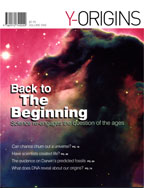THE LANGUAGE OF OUR CELLS
Does DNA Point to a Designer?
Was the language of DNA programmed by a designer–or by chance?
Consider for a moment the cathedral-like structure of a snowflake under a microscope. Look at the beauty. Look at the complexity. Look at the originality of each individual flake. Surely this is evidence for a grand designer in the universe.
Well, no, actually it’s not—no more so than the burned enchilada of a woman in Mexico that apparently revealed the image of Jesus (though in the photo it did kind of look like him).
Although crystalline forms of a snowflake are beautiful and impressive, designs of this type abound in nature, and natural processes can and do produce them.
Neo-Darwinists believe that natural selection and favorable mutations are the total explanation for the appearance of design in nature.
But what if complexity in nature is discovered that is not explainable by natural selection and chance mutations? What if, unlike our snowflake and enchilada examples, scientists discover a form of complexity that exceeds all human engineering and all sophisticated software programs? This raises an important question: How would we be able to detect intelligent design in nature if it actually exists?
Endnotes | Next
|




